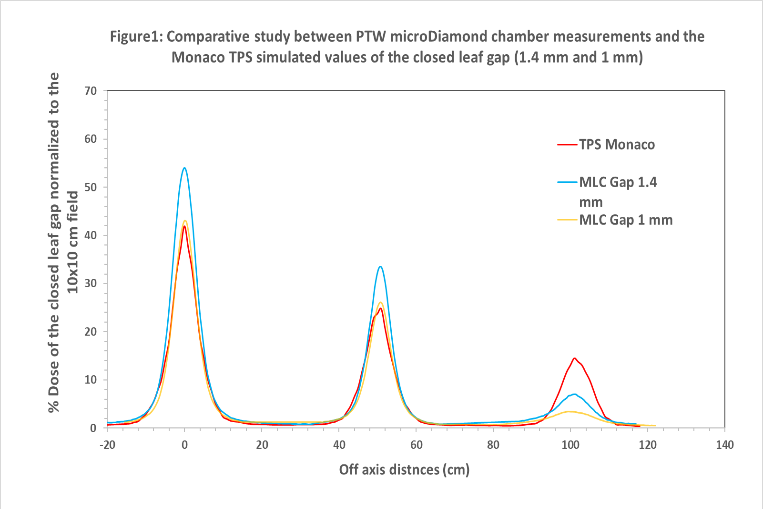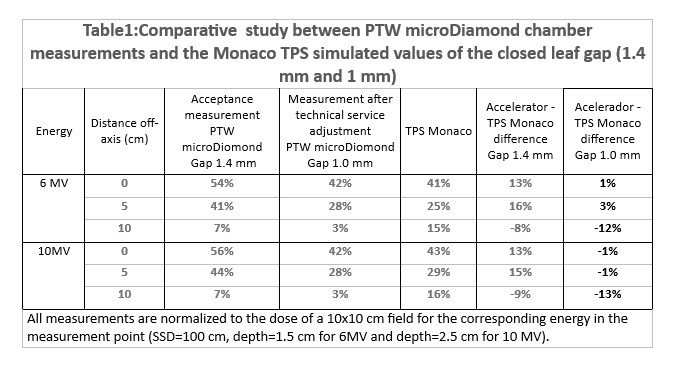Modelling the MLC Agility transmission radiation through the closed leaf gap in the Monaco TPS
Maria Aurora Vicedo González,
Spain
PO-1517
Abstract
Modelling the MLC Agility transmission radiation through the closed leaf gap in the Monaco TPS
Authors: Maria Aurora Vicedo González1, Maria Trinitat García Hernández1, Domingo Planes Meseguer2, Rafael García Molla1, Begoña Bordería Navarro1, Patricia Calatayud Cuesta1, Maria Luisa Alcaraz Lozano1
1Consorcio Hospital General of Valencia, Medical Physics, Valencia, Spain; 2Consorcio Hospital General of Valencia, Medical Physics, Valencia, Spain
Show Affiliations
Hide Affiliations
Purpose or Objective
The Elekta Agility MLC is designed with rounded end
tip leaves. This MLC design allows to control the penumbra for different field
sizes despite the linear MLC motion that does not adapt to the variation of
the beam’s divergence. One of the peculiarities of this system is that, in
order to avoid possible collisions, the leaves cannot be completely closed and therefore
the radiation transmission through the radiation axis is very high. This
transmission can be reduced by closing the leaves off axis because the
divergent beam passes through a wider portion of the leaf, reducing therefore
the transmission. The treatment system planning (TPS) models this effect by physically changing the width
of the gap between leaves as the gap moves off axis. The aim of this work is to
verify the correct modelling of the radiation transmission through the gap in
the Monaco TPS as a function of the distance to the radiation axis.
Material and Methods
The radiation transmission through
the closed leaf gap was measured in the radiation axis and 5, 10 cm
off axis in a VersaHD accelerator
equipped with an Agility MLC and energies of 6MV and 10MV. Measurements were
made with a PTW micro-diomond chamber at DFS=100cm, depth =1. 5 cm (6MV) and
depth=2. 5 cm (10MV) . Measurements were normalized to a 10x10 cmxcm field delivered in
the same conditions. The results were compared to the calculations made in the
TPS Monaco v. 5. 51 with a 2 mm resolution calculation matrix, MonteCarlo
algorithm and an uncertainty of 0.5% per calculation.
Results
In the accelerator acceptance,
a closed leaf gap of 4.5 mm was physically measured at the isocenter (1.4 mm at the leaves plane).
The radiation transmission measured for 6MV-10MV energies with respect to the
10x10 field was 54-56% on the radiation axis, 41-44% at 5 cm off axis and 7% at
10 cm off the axis. The differences between the measurements and the TPS Monaco
for 6MV-10MV energies were 13%, 15-16% and 8-9% at 0, 5 and 10 cm off axis respectively.
Technical service was requested to close the gap to 1 mm at the plane of the leaves
(3.5 mm at the isocenter), as this is the value recommended by Elekta. Once the
gap was closed, the transmission measured at the same positions, for 6MV-10MV energies,
was 42-45%, 28% and 3%.
The differences to the TPS were 1-2%, 3-1% and 12%.Table 1 and Figure 1
summarize the results obtained.


Conclusion
The TPS Monaco models successfully the reduction
in the radiation transmission when the closed gap moves off axis, provided the MLC Agility gap measures
physically 1 mm at the leaves plane. The existence of this minimun gap between
adjacent leaves makes it necessary to close the gap off axis in order to reduce
the transmission radiation through it. During the accelerator commissioning,
the size of this gap should be checked to ensure minimum transmission. In the
case of dynamic treatments in which the leaves are closed within the field, the
correct modelling of this parameter is particularly important.